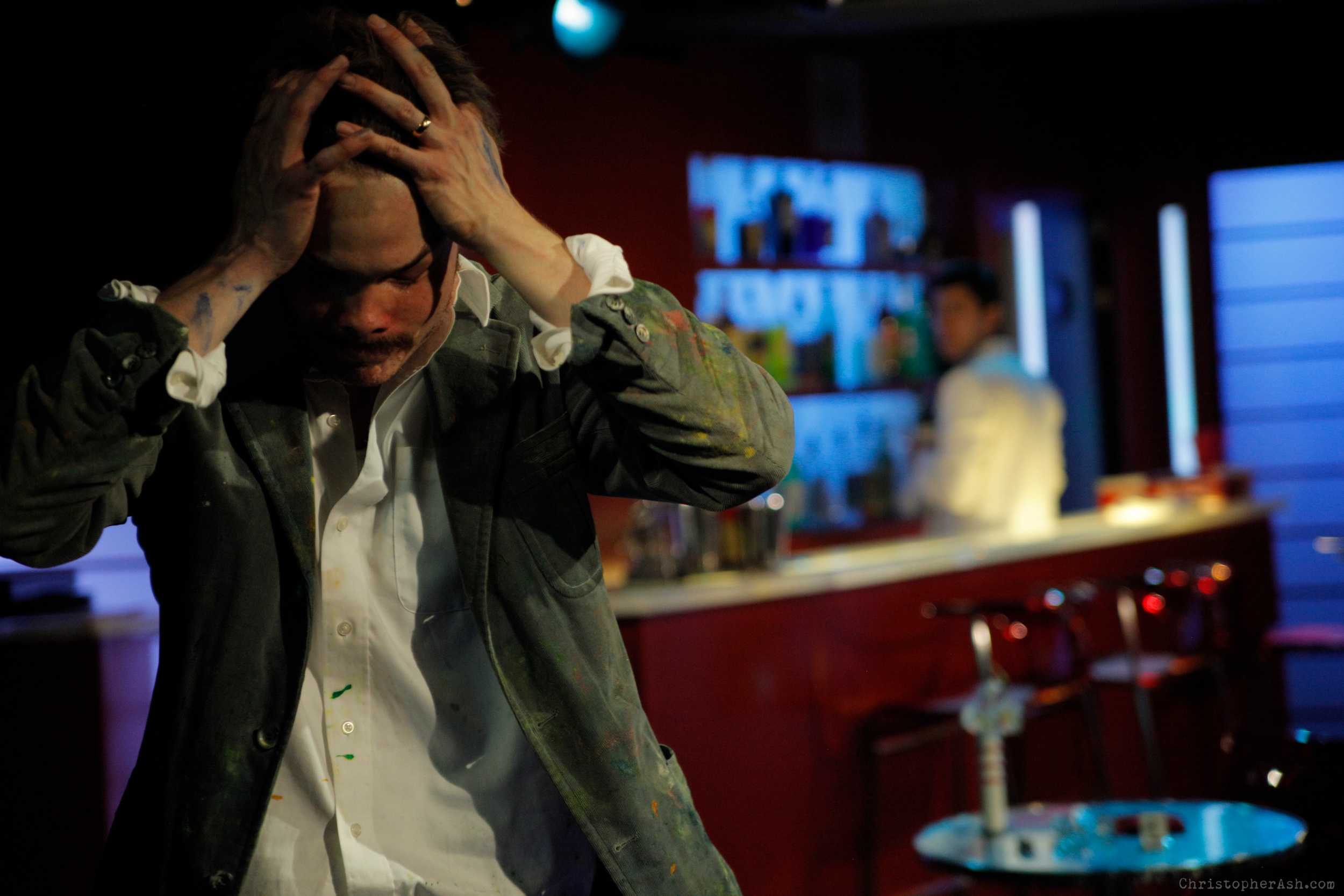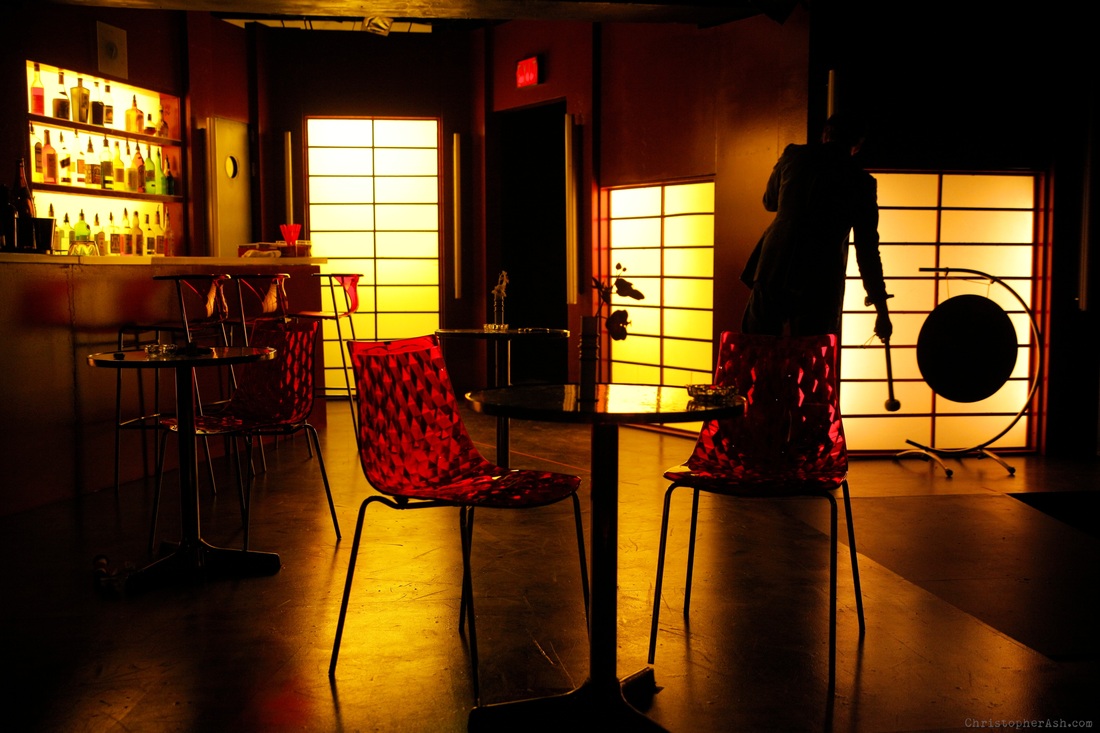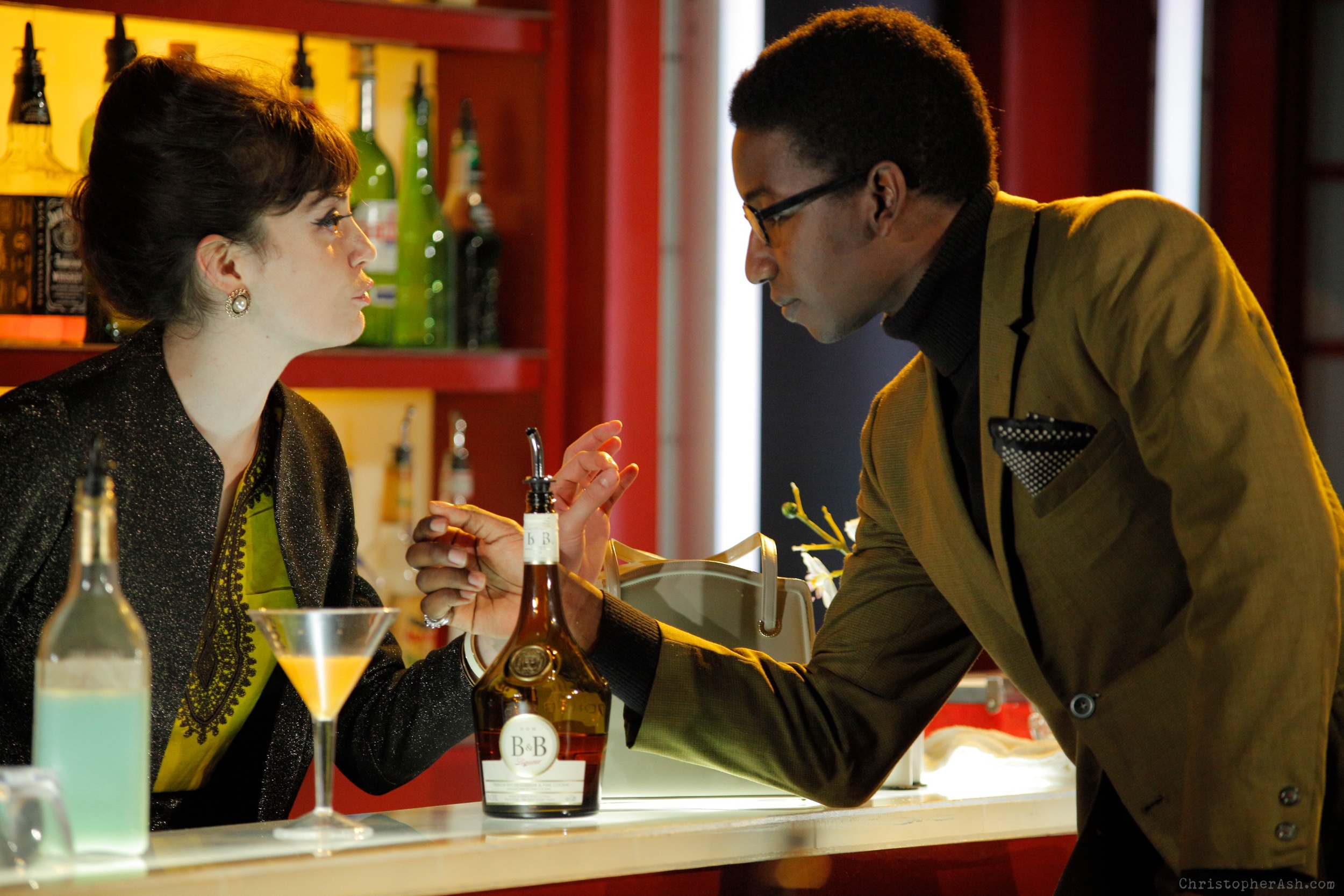Tennessee Williams’ In the Bar of a Tokyo Hotel is not one of his better-known plays and it’s easy to guess why. The situation of its leads—he’s an artist of the American Neo-Expressionist variety, she’s a rapacious female of the liberated sex object variety, and they’re abroad in Tokyo in the Sixties, at a hotel where the only other in situ character is a Japanese barman rather nonplussed at their erratic ways—is a bit too specialized perhaps. We know Williams can write good female characters, and Miriam is no exception; it’s a plum role and one would expect top actresses to want to give it a try. The problem is the character of Mark who is having a nervous breakdown and creative difficulties. The imperfections of the male lead, one assumes, is what has kept the play from getting much revival. The production directed by Chris Bannow at the Yale Summer Cabaret, then, is to be applauded for giving it a shot and for succeeding so well. Watching the play, there’s no reason to suspect we’re experiencing a “problem play” and that’s in part because the approach here is to accept the play’s oddities, neither turning them into camp nor trying to smooth them over with earnest naturalism. We have to allow for Miriam’s soliloquies, spoken into a spotlight; we have to accept the staccato deliveries of unfinished lines, the many times a statement is stopped and redirected in mid-flight. One suspects that those who panned the play couldn’t distinguish dialogue where characters cut each other off and leave their thoughts hanging from dialogue where actors flub their lines and forget how a speech ends. It’s risky to be so erratic in speech, but Bannow’s cast manages, for the most part, to make the lurches in communication part of the communication.
The effect of the whole is greatly served by the set (Seth Bodie, Scenic Design)—it exudes the cool rigor of a Japanese restaurant, with plenty of neon and colorful liquor bottles that avoid the seediness Williams often reeks of. With the impeccable barman (Mitchell Winter) in place and the Formica tables all gracefully decorated with a single flower in a thin columnar vase, the bar is more formal than inviting. It’s the kind of place that should help one keep the demons at bay. And that’s why—we imagine—Miriam is hanging out there.
But, as she quickly makes us aware, Miriam is the kind of woman who sees no point to a man unless he wants her. So, her task is to use her wiles to convince the barman he should be interested. The fact that he isn’t, and is even comically put out by her overtures—some simply coy and flirtatious, some outright indecent—is the business that occupies the opening segment, with Winter providing spirited support as the kind of non-character (he never drops his “I’m just a barman” demeanor) so essential to the scene. This part of the play establishes Miriam, in Celeste Arias’s very capable hands, as an entertaining character with full emphasis on the latter term. Miriam is a “character,” a life of the party type only too happy to praise her own vitality and her tendency to “manipulate” male genitals in her free time. In her lime green dress with straight lines out of Mary Quant, her hair and false eyelashes à la Twiggy, Miriam is a creature of the late Sixties that all concerned—Williams, Bannow, Arias, and Kate Noll’s moddish costumes—get exactly right. The voice, the cigarette, the body language bespeak an “It Girl” still looking for “it.”
The play’s problems start when Mark enters the picture, flaunting his paint-daubed suit and so clearly not the kind of man we’d expect Miriam to be mixed up with. An eventual stab at back-story lets us know that she was aroused by his timidity and seduced him. And her utter disparagement of his current work seems to stand upon the fact that he used to be something. In other words, the man she’s with is not the man she married and we meet Miriam around the time that she’s decided to escape one way or another—either by means of a little poison pellet she carries around in a snuffbox or by means of having Mark shipped—sedated on a stretcher—back to the States, leaving her free to pursue that world of hotels and room service she’s been longing for.
All well and good, but what’s the deal with Mark anyway? As played by Mickey Theis, the artist still seems to have plenty of vitality even though he’s a shaking mess unable to walk very far on his own who needs his wife to—literally—pour drinks down his throat. And, while it may seem a bit monomaniacal, a claim to have just “invented color” is not unusual as the kind of hyperbole artists use about their vision—and it’s a cue for this production to achieve some wonderful effects with lights (Oliver Wason) and color, as when Mark bangs a gong and shifts the color scheme dramatically at the end of Act I. (Kudos as well to the interesting shifts in soundscape via James Lanius. The production values of this show are superb.)
Mark’s a shambles yes, but his dealer—the dapper, gay, and somewhat Southern Leonard who arrives thanks to a summons from Miriam—seems to think Mark’s ravings are par for the course. One suspects that Williams wants Leonard to be a sympathetic character, a man who sees worth where Miriam sees only ravaged delusions, but the production here seems not to back that up. As Leonard, Mamoudou Athie is affected in a way that puts us on our guard. He seems to have no real warmth or regard for the realities Miriam is living with. He finally steps out of his coolness, but only to upbraid Miriam with an anecdote from his childhood that Athie makes both terse and affecting.
So, Mark. I keep returning to my sense that Williams didn’t really know how to write this character. Given the playwright’s penchant for macho brutes—Stanley Kowalski—and dissolute athletes—Brick—we might think that a macho and dissolute Abstract Expressionist—à la Jackson Pollock—shouldn’t be a stretch, and yet…. It’s hard to say what Mark is on about—when he starts raving about needing a long white beard and a step-ladder so as to equal the Michelangelo of the Sistine Chapel, to recreate the creation of the Creation, we know we’re supposed to see the torment of someone trying to be a grand “Creator,” but one can’t help wishing that Williams made Mark one of those sloppy drunks who likes talking about when he was a boy. Something anecdotal would help sell this guy. Theis does his best with the grand ravings, at one point on top of a table, and there’s some well-choreographed wrestling between Mark and Miriam that lets us see what it’s all come to.
In the end Mark as artist figure seems a bit mismatched. Who works in hotel rooms? Writers, not painters. And why Tokyo? We might assume Miriam speaks for her author when she touts the discovery that, to her liking, Japanese men have not much hair on their bodies, so that slumming in Japan might just be one of the things one does as the Sixties come to an end, far from home and lost in translation.
I really wanted Miriam to have her way—ditch the stiff and get on with the grand tour. The end, in which a refusal to mourn morphs into a stripping away of falsity, makes for a borderline mad scene that feels true enough, and lets Arias pull out the stops, but, because her Miriam looks so good, we have to work to imagine her as pathetic as Williams wants her to be. Yes, as she says, at some point she’ll look in the mirror and know it’s all over for her, but “ah, my foes, and, oh, my friends—”
In the Bar of a Tokyo Hotel By Tennessee Williams Directed by Chris Bannow
Stage Manager: Rob Chikar; Scenic Designer: Seth Bodie; Costume Designer: Kate Noll; Lighting Designer: Oliver Wason; Sound Designer: James Lanius; Production Manager/Technical Director: James Lanius; Assistant Technical Director: Joey Moro
Photographs by Christopher Ash, courtesy of Yale Summer Cabaret
Yale Summer Cabaret July 25-August 3, 2013





